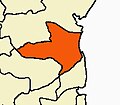Pennadam
Pennadam | |
|---|---|
Town | |
| Nickname: PNDM | |
| Country | |
| State | Tamil Nadu |
| District | Cuddalore |
| Elevation | 54 m (177 ft) |
| Population (2011) | |
| • Total | 19,494 |
| Languages | |
| • Official | Tamil |
| Time zone | UTC+5:30 (IST) |
Pennadam is a panchayat town in Cuddalore district in the Indian state of Tamil Nadu.
Geography
Pennadam has an average elevation of 54 metres (177 feet). Sudarkozhundeeswarar Temple was built in the early Chola period.
Demographics
As of 2001[update] India census,[1] Pennadam had a population of 17,142. Males constitute 51% of the population and females 49%. Pennadam has an average literacy rate of 65%, higher than the national average of 59.5%: male literacy is 73%, and female literacy is 56%. In Pennadam, 11% of the population is under 6 years of age. Pennadam is famous for a temple with a difference. The bull(Nandi) which usually faces the statue of god will face the town along with the statue. Pennadam the name in Tamil comes through the belief in the story behind this temple penn(Lady) Aha(Cow) Gatam(Elephant). It is believed that the bull which faces the town along with the statue is to protect the people from floods and disasters.
This town is mostly dependent on agriculture, especially sugarcane. Some of the industrial companies contributing to the growth of this town are India cements, Madras cements and Ambika sugars. Large volumes of cements, sugarcane and molasses are transported. Agriculture and related industries are the major source of income to the people in this region.
Meykandar is believed to be born at this place and there is temple dedicated to him. Meykandar is a core philosopher of Shaiva Siddhanta. Meykandar is the author of Sivagnanabodham - the siddhanta philosophy text.
References
- ^ "Census of India 2001: Data from the 2001 Census, including cities, villages and towns (Provisional)". Census Commission of India. Archived from the original on 2004-06-16. Retrieved 2008-11-01.

